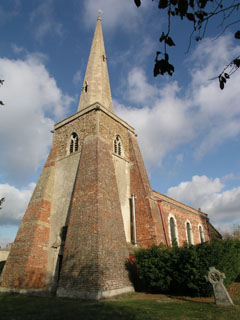I laughed out loud when I first saw this church. Poor St Mary's - it has been through the wars and suffered rather worse than most. An avenue of neatly clipped yews leads to the west tower, the only part of the medieval church that remains. It is clasped by huge pyramidal brick buttresses on the corner, which emphasise just how slight the tower was anyway. It shrugs slightly in its straight jacket, and there are cracks in the stucco, but it seems stable enough. The nave was evidently in an even worse state [Mark adds: not helped, one suspects, by Dowsing - who broke sixty-nine 'superstitious pictures' in the windows and 'gave order to take down 36 cherubims' from the roof in 1643], since it was replaced completely by a Georgian brick building of 1737 - I presume that the tower was buttressed at the same time. They even went to the length of punching an elegant doorway in the western face of the tower, complete with bull-eye window above: a Kensington portal transposed rather dramatically into the Cambridgeshire borderlands. It's a shame that the old nave went, of course, but I rather like the replacement - much better than the bland Victorian chancel, anyway.
Sadly we weren't able to get inside the church: there are keyholders listed, but both of them were out. Pevsner says that there is a monument with stonecarving by the great Grinling Gibbons inside. Next time we're thundering up the A14 and fancy a bit of whimsy, we'll stop and have a look...
Oh, and when we were driving away, I saw a black squirrel in a hedgerow. How rare.
St Mary's is kept locked, but there are keyholders listed
